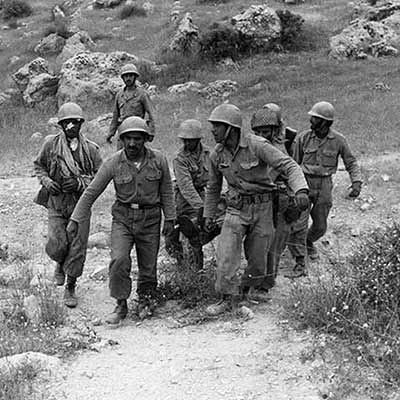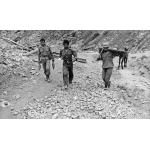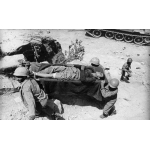Battles
Matla al-Fajr
Leila Heidari Bateni
207 دورہ
In late 1981, Operation Matla al-Fajr was launched under the joint command of the Islamic Republic of Iran Army and the Islamic Revolutionary Guard Corps (IRGC) in Gilan-e Gharb, Kermanshah Province. The objective was to capture the Shiyakuh Mountains and surrounding areas. However, the Iranian forces could not retain the seized territories due to a lack of logistical support.
With the onset of the Iran-Iraq War on September 22, 1980, Iraq initially advanced into Iran’s western provinces, occupying strategic heights in Gilan-e Gharb, including Shiyakuh and Charmian where it established strong defensive positions. On the other hand, by occupying observation posts along the border, the Iraqis not only monitored Iranian military activities from a distance but also reinforced their defensive position by creating extensive minefields and fortifications to prevent Iranians from carrying out further attacks. In October 1981, the 58th Zulfaqar Brigade of the Iranian Army developed the Zulfaqar 1 Plan, in an attempt to penetrate up to ten kilometers behind Iraqi fortifications. [1]
Initially named “Karbala 7” and later renamed “Operation Matla al-Fajr”, the plan was going to be carried out in the northwest of Gilan-e Gharb and the southwest of Sarpol-e Zahab, covering the heights of Charmian, Shiyakuh, Tang-e Qasem, and the general Gilan-e Gharb area, including the plains located between the mountains and the Gilan River, known as the Gilan Plain. [2]
The operation aimed to pave the way for the liberation of Qasr-e Shirin, taking control over Naft-Shahr in Iran as well as Naft-Shahr and Ban-Mil in Iraq, and supporting major operations launched on the southern front, such as the liberation of Bostan. [3]
Accordingly, the 81st Armored Division of the Army was assigned to carry out Operation Matla al-Fajr with the 58th Infantry Brigade on the northern front and the 3rd Brigade on the southern fronts in Gilan-e Gharb – Qasr-e Shirin. Based on the plan, the 3rd Armored Brigade would attack from north to southwest and capture Tang-e Korak Heights and northern Tang-e Qasemabad, while the 58th Infantry Brigade would advance from the northwest and seize the Charmian and Shiyakuh Mountains, south of Tang-e Qasem. [4]
Under the command of the forward headquarters of the Iranian Army Ground Forces and in coordination with the IRGC, the operation started at 3:00 AM on December 11, 1981, under the code-name “Ya Mahdi (as) Adrekni” and finished after seventeen days on December 27th.[5]
The battle occurred across four main fronts—Bansiran, Shiyakuh, Charmian, and Gilan Plain—and one secondary one, Baraftab, each of which consisted of four subsidiary axes for penetrating enemy defensive positions. In the Bansiran–Shiyakuh front, six battalions from the IRGC, one battalion from the Zulfaqar Brigade, and a tank platoon from the Army started moving forward along four axes. The engagement in the first axis would result in capturing the Fereydoun Koshiyar, Chale Badam, Beznili, and Anar Heights, as well as Hills 4 and 5 located on the eastern slope of Fereydoun Koshiyar. The second axis saw two IRGC battalions and the 1st Battalion of the 58th Army Brigade liberate Shiyakuh, Hassan, and Hussain Heights. On the third axis, an IRGC battalion and a company from the 1st Battalion of the 58th Brigade managed to take control of the Dareh-Gar, Chel-Kasan, and Talvar Heights. However, an IRGC battalion arrived late to its designated area in the fourth axis, leading to a setback in the Charmian front, and thus the Iranian forces had to retreat. [6]
On the Charmian front, Iranian forces attacked from four directions. In the first axis, an IRGC battalion, the 1st Company of the 3rd Battalion of the Zulfaqar Brigade, and a tank unit successfully captured Gachi 1 and 2 as well as Charmian Heights. However, the martyrdom of key commanders and the disorganization of the forces led to the failure to secure the liberated zones. In the second axis, an IRGC battalion and a company from the 3rd Battalion of the 58th Brigade reached the Kelineh and Kasr Khan Mountains, as well as the Serttan Observation Post but could not retain the occupied areas except the last one. Moreover, three enemy tanks were captured. In the third axis, an IRGC battalion and a company from the 3rd Battalion of the 85th Zulfaqar Brigade reached their objectives, liberating Kalk-e Tala and Dizekesh Heights where several Iraqi soldiers were captured, two 130 mm enemy artillery pieces were destroyed with RPGs, and an Iraqi helicopter was shot down. In the fourth axis, Iraqi forces held the right flank at Tang-e Qasemabad, and the Iranian forces failed to achieve their objectives in the Baraftab front, preventing further advancement towards the Serttan. [7]
On December 11, IRGC and Army commanders, along with the Joint Chiefs of Staff, stated the initial results of the operation. On the same day, Imam Khomeini (ra) congratulated the soldiers and commanders on their achievements. However, on that day, Gholam-Ali Pichak, who had commanded the forces in Tang-e Kork axis, was martyred. [8]
On the Gilan Plain front, east of Charmian Mountain, Iranian forces launched the attack from four subsidiary axes. In the first axis, an IRGC battalion and a company from the 2nd Battalion of the 58th Zulfaqar Brigade captured Peak 920 as well as Morad and Sadafi Heights. Still, they were forced to retreat due to the Iraqi's control over Charmian Heights. The forces fighting in the second axis failed to advance towards Marjan Heights due to the failure to capture Abrouei Moshkanan Mountain. In the third axis, the Iranian forces could only secure a position on the Sarpol-e Zahab – Qasr-e Shirin Road due to the martyrdom of the commander and inadequate reconnaissance. In the fourth axis, IRGC guerrilla forces were tasked with capturing Bureh Savar, Qeytol Marjan, Marjan, and Gamqal Heights, but the martyrdom of the commander and failures in Charmian and Tang-e Kork fronts prevented their success. [9]
Despite initial success on the Baraftab front in capturing parts of the heights located behind Tang-e Kork, Tang-e Qasemabad, and Baraftab, the Iranians had to withdraw due to insufficient reconnaissance and heavy Iraqi resistance. While most of the objectives were achieved in the southern axis (Shiyakuh and Charmian), the northern one did not see the same success. [10]
The continuous and heavy Iraqi counterattacks on the one hand, and the inability of Iranian forces to provide logistics due to the long distance between the front lines and supply bases on the other, caused the operation to end after seventeen days without Iranian forces being able to secure the occupied areas. [11]
Overall, the operation resulted in the liberation of Charmian, Shiyakuh, Dizekesh, Baraftab, Tang-e Kork, and Dasht-e Shaknian Heights, in addition to villages such as Gar, Gorsefid, and Gorsevar in Gilan-e Gharb Plain. In addition, an Iraqi helicopter was downed, over 1,700 Iraqi soldiers were killed or wounded, and 140 were captured. The Iraqi 2nd, 36th, 412th, 425th, and 503rd Infantry Brigades, the 4th Tank Battalion, and the 32nd Special Forces Brigade suffered heavy losses, with significant damage to Iraq’s commando units. [12]
[1] Jafari, Mojtabi, Atlas-e Nabardha-ye Mandegar (Atlas of Memorable Battles), Tehran: Nowdid Tarrahan, 1383, p. 66.
[2] Lotfollahzadegan, Alireza, Roozshomar-e Jang-e Iran va Araq (Chronology of the Iran-Iraq War), Book 16: Azadsazi-ye Sarzaminha-ye Iran, Gham-e Dovom: Bostan (Liberation of Iranian Territories, Second Step: Bostan), Tehran: Markaz-e Motaleat va Tahqiqat-e Jang-e Sepah-e Pasdaran-e Enqelab-e Eslami, 1394, Pp. 939–1152; Rashid, Mohsen, Atlas-e Jang-e Iran va Araq (Atlas of the Iran-Iraq War), Tehran: Markaz-e Motaleat va Tahqiqat-e Jang-e Sepah-e Pasdaran-e Enqelab-e Eslami, 1389, p. 56; Taqvim-e Tarikh-e Defa-e Muqaddas (Calendar of Sacred Defense History), Vol. 16: Fath-e Bostan (The Liberation of Bostan), Tehran: Markaz-e Asnad-e Enqelab-e Eslami, 1384, Pp. 518–520.
[3]Kazemi, Asghar, Bamu (Bamu), Tehran: Sureh-ye Mehr, 1379, p. 50.
[4]Taqvim-e Tarikh-e Defa-e Muqaddas (Calendar of the Sacred Defense History), Vol. 16, Pp. 518–520.
[5] Lotfollahzadegan, Alireza, Roozshomar-e Jang-e Iran va Araq (Chronology of the Iran-Iraq War), Book 16, Pp. 939–1152; Rashid, Mohsen, Atlas-e Jang-e Iran va Araq (Atlas of Iran-Iraq War), p. 56.
[6] Lotfollahzadegan, Alireza, Roozshomar-e Jang-e Iran va Araq (Chronology of the Iran-Iraq War), Book 16, p. 937.
[7] Ibid., p. 939.
[8] Babaei, Gol-Ali, Jebheh-ye Baghdad: Karnameh-ye Amaliyati-ye Jebheh-ye Gharb dar Hasht Sal Defa-e Muqaddas (The Baghdad Front: Operational Record of the Western Front During the Eight Years of Sacred Defense), Tehran: Saeqeh, 1395, p. 108.
[9] Lotfollahzadegan, Alireza, Roozshomar-e Jang-e Iran va Araq (Chronology of the Iran-Iraq War), Book 16, Pp. 1152–1155; Rashid, Mohsen, Atlas-e Jang-e Iran va Araq (Atlas of the Iran-Iraq War), p. 56.
[10] Lotfollahzadegan, Alireza, Roozshomar-e Jang-e Iran va Araq (Chronology of the Iran-Iraq War), Book 16, p. 940.
[11] Rashid, Mohsen, Atlas-e Jang-e Iran va Araq (Atlas of the Iran-Iraq War), p. 56.
[12]Ibid., p. 66; Taqvim-e Tarikh-e Defa-e Muqaddas (Calendar of the Sacred Defense History), Vol. 16, p. 497.





